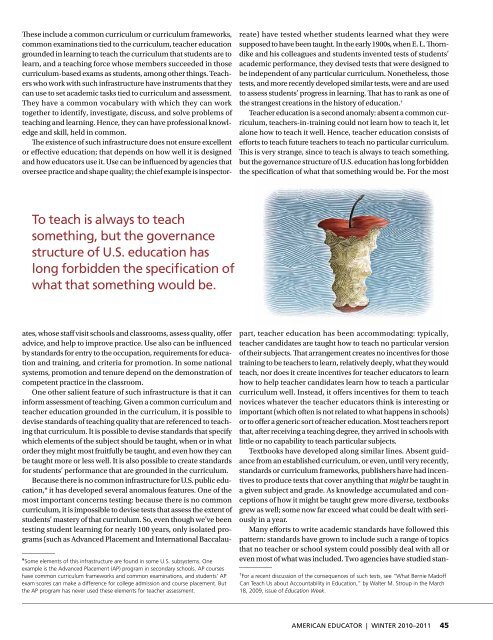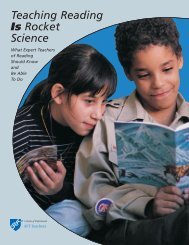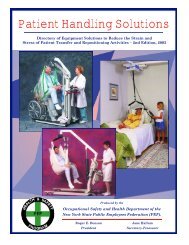American Educator, Winter 2010-11, Vol. 34, No. 4, AFT
American Educator, Winter 2010-11, Vol. 34, No. 4, AFT
American Educator, Winter 2010-11, Vol. 34, No. 4, AFT
You also want an ePaper? Increase the reach of your titles
YUMPU automatically turns print PDFs into web optimized ePapers that Google loves.
Th ese include a common curriculum or curriculum frameworks,<br />
common examinations tied to the curriculum, teacher education<br />
grounded in learning to teach the curriculum that students are to<br />
learn, and a teaching force whose members succeeded in those<br />
curriculum-based exams as students, among other things. Teachers<br />
who work with such infrastructure have instruments that they<br />
can use to set academic tasks tied to curriculum and assessment.<br />
They have a common vocabulary with which they can work<br />
together to identify, investigate, discuss, and solve problems of<br />
teaching and learning. Hence, they can have professional knowledge<br />
and skill, held in common.<br />
Th e existence of such infrastructure does not ensure excellent<br />
or eff ective education; that depends on how well it is designed<br />
and how educators use it. Use can be infl uenced by agencies that<br />
oversee practice and shape quality; the chief example is inspector-<br />
To teach is always to teach<br />
something, but the governance<br />
structure of U.S. education has<br />
long forbidden the specifi cation of<br />
what that something would be.<br />
ates, whose staff visit schools and classrooms, assess quality, off er<br />
advice, and help to improve practice. Use also can be infl uenced<br />
by standards for entry to the occupation, requirements for education<br />
and training, and criteria for promotion. In some national<br />
systems, promotion and tenure depend on the demonstration of<br />
competent practice in the classroom.<br />
One other salient feature of such infrastructure is that it can<br />
inform assessment of teaching. Given a common curriculum and<br />
teacher education grounded in the curriculum, it is possible to<br />
devise standards of teaching quality that are referenced to teaching<br />
that curriculum. It is possible to devise standards that specify<br />
which elements of the subject should be taught, when or in what<br />
order they might most fruitfully be taught, and even how they can<br />
be taught more or less well. It is also possible to create standards<br />
for students’ performance that are grounded in the curriculum.<br />
Because there is no common infrastructure for U.S. public education,*<br />
it has developed several anomalous features. One of the<br />
most important concerns testing: because there is no common<br />
curriculum, it is impossible to devise tests that assess the extent of<br />
students’ mastery of that curriculum. So, even though we’ve been<br />
testing student learning for nearly 100 years, only isolated programs<br />
(such as Advanced Placement and International Baccalau-<br />
*Some elements of this infrastructure are found in some U.S. subsystems. One<br />
example is the Advanced Placement (AP) program in secondary schools. AP courses<br />
have common curriculum frameworks and common examinations, and students’ AP<br />
exam scores can make a difference for college admission and course placement. But<br />
the AP program has never used these elements for teacher assessment.<br />
reate) have tested whether students learned what they were<br />
supposed to have been taught. In the early 1900s, when E. L. Th orndike<br />
and his colleagues and students invented tests of students’<br />
academic performance, they devised tests that were designed to<br />
be independent of any particular curriculum. <strong>No</strong>netheless, those<br />
tests, and more recently developed similar tests, were and are used<br />
to assess students’ progress in learning. Th at has to rank as one of<br />
the strangest creations in the history of education. †<br />
Teacher education is a second anomaly: absent a common curriculum,<br />
teachers-in-training could not learn how to teach it, let<br />
alone how to teach it well. Hence, teacher education consists of<br />
eff orts to teach future teachers to teach no particular curriculum.<br />
Th is is very strange, since to teach is always to teach something,<br />
but the governance structure of U.S. education has long forbidden<br />
the specifi cation of what that something would be. For the most<br />
part, teacher education has been accommodating: typically,<br />
teacher candidates are taught how to teach no particular version<br />
of their subjects. Th at arrangement creates no incentives for those<br />
training to be teachers to learn, relatively deeply, what they would<br />
teach, nor does it create incentives for teacher educators to learn<br />
how to help teacher candidates learn how to teach a particular<br />
curriculum well. Instead, it offers incentives for them to teach<br />
novices whatever the teacher educators think is interesting or<br />
important (which often is not related to what happens in schools)<br />
or to off er a generic sort of teacher education. Most teachers report<br />
that, after receiving a teaching degree, they arrived in schools with<br />
little or no capability to teach particular subjects.<br />
Textbooks have developed along similar lines. Absent guidance<br />
from an established curriculum, or even, until very recently,<br />
standards or curriculum frameworks, publishers have had incentives<br />
to produce texts that cover anything that might be taught in<br />
a given subject and grade. As knowledge accumulated and conceptions<br />
of how it might be taught grew more diverse, textbooks<br />
grew as well; some now far exceed what could be dealt with seriously<br />
in a year.<br />
Many eff orts to write academic standards have followed this<br />
pattern: standards have grown to include such a range of topics<br />
that no teacher or school system could possibly deal with all or<br />
even most of what was included. Two agencies have studied stan-<br />
† For a recent discussion of the consequences of such tests, see “What Bernie Madoff<br />
Can Teach Us about Accountability in Education,” by Walter M. Stroup in the March<br />
18, 2009, issue of Education Week.<br />
AMERICAN EDUCATOR | WINTER <strong>2010</strong>–20<strong>11</strong> 45





